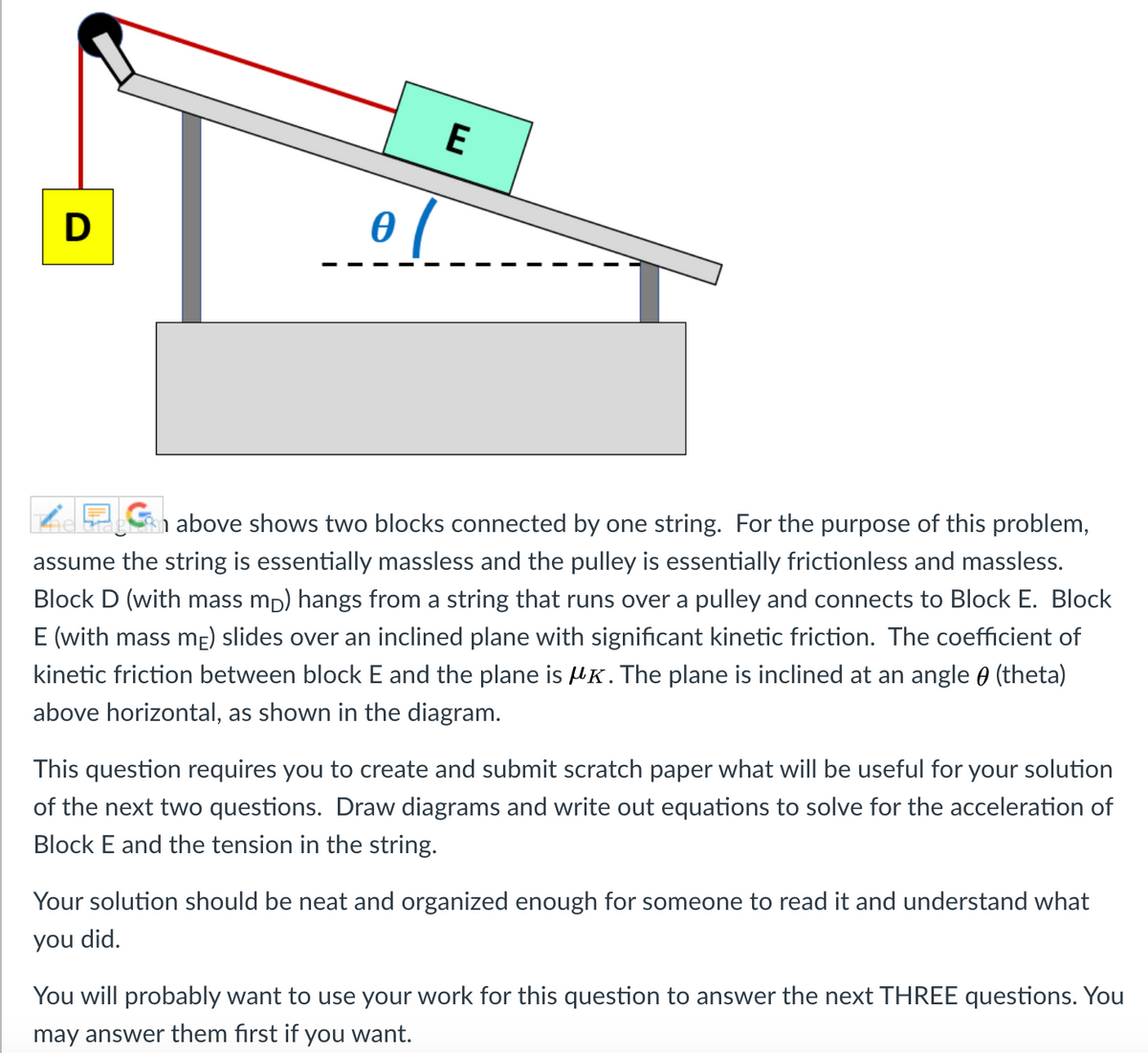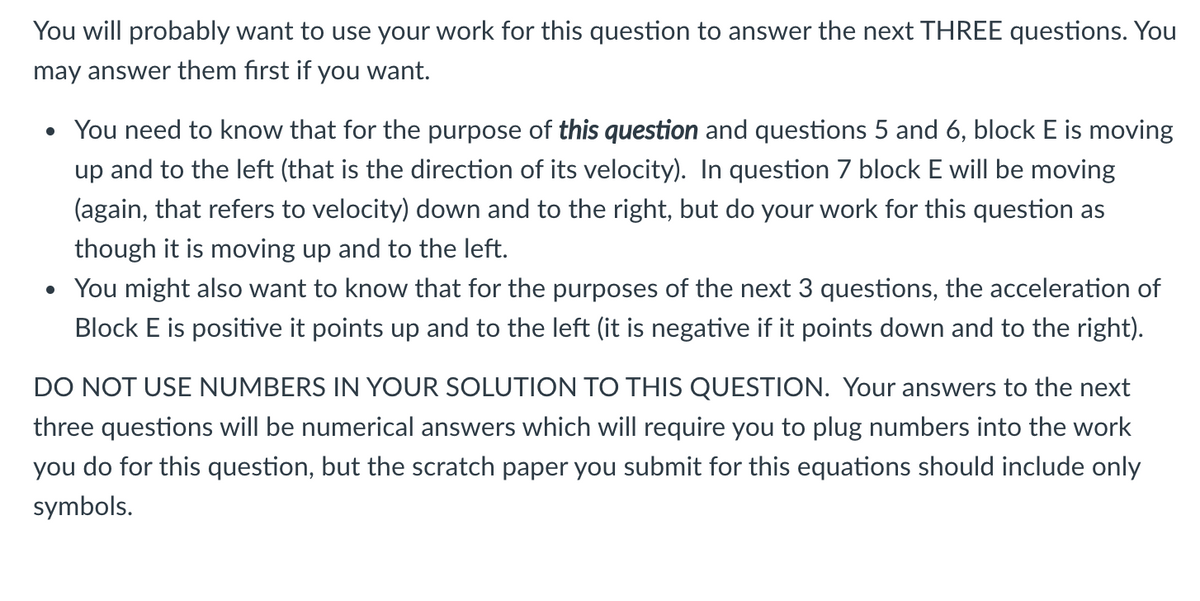Block E is moving up and to the left (and Block D is moving down). The mass of Block D is 3.8 kg. The mass of Block E is 2.9 kg. The coefficient of kinetic friction between Block E and the plane is 0.42. The inclined plane is inclined at an angle of θ = 24 degrees above horizontal. Calculate the acceleration of Block E (in units of meters per second squared). For the purpose of this question, the acceleration is positive it points up and to the left (it is negative if it points down and to the right).
Block E is moving up and to the left (and Block D is moving down). The mass of Block D is 3.8 kg. The mass of Block E is 2.9 kg. The coefficient of kinetic friction between Block E and the plane is 0.42. The inclined plane is inclined at an angle of θ = 24 degrees above horizontal. Calculate the acceleration of Block E (in units of meters per second squared). For the purpose of this question, the acceleration is positive it points up and to the left (it is negative if it points down and to the right).
Classical Dynamics of Particles and Systems
5th Edition
ISBN:9780534408961
Author:Stephen T. Thornton, Jerry B. Marion
Publisher:Stephen T. Thornton, Jerry B. Marion
Chapter2: Newtonian Mechanics-single Particle
Section: Chapter Questions
Problem 2.51P: Let us make the (unrealistic) assumption that a boat of mass m gliding with initial velocity v0 in...
Related questions
Question
Could you please answer the question in the image and this one below that follows the image.
Question 5. The situation for this problem is as explained in question 4.
Block E is moving up and to the left (and Block D is moving down).
The mass of Block D is 3.8 kg.
The mass of Block E is 2.9 kg.
The coefficient of kinetic friction between Block E and the plane is 0.42.
The inclined plane is inclined at an angle of θ = 24 degrees above horizontal.
Calculate the acceleration of Block E (in units of meters per second squared). For the purpose of this question, the acceleration is positive it points up and to the left (it is negative if it points down and to the right).

Transcribed Image Text:E
above shows two blocks connected by one string. For the purpose of this problem,
assume the string is essentially massless and the pulley is essentially frictionless and massless.
Block D (with mass mp) hangs from a string that runs over a pulley and connects to Block E. Block
E (with mass mE) slides over an inclined plane with significant kinetic friction. The coefficient of
kinetic friction between block E and the plane is HK. The plane is inclined at an angle ) (theta)
above horizontal, as shown in the diagram.
This question requires you to create and submit scratch paper what will be useful for your solution
of the next two questions. Draw diagrams and write out equations to solve for the acceleration of
Block E and the tension in the string.
Your solution should be neat and organized enough for someone to read it and understand what
you did.
You will probably want to use your work for this question to answer the next THREE questions. You
may answer them first if you want.

Transcribed Image Text:You will probably want to use your work for this question to answer the next THREE questions. You
may answer them first if you want.
• You need to know that for the purpose of this question and questions 5 and 6, block E is moving
up and to the left (that is the direction of its velocity). In question 7 block E will be moving
(again, that refers to velocity) down and to the right, but do your work for this question as
though it is moving up and to the left.
• You might also want to know that for the purposes of the next 3 questions, the acceleration of
Block E is positive it points up and to the left (it is negative if it points down and to the right).
DO NOT USE NUMBERS IN YOUR SOLUTION TO THIS QUESTION. Your answers to the next
three questions will be numerical answers which will require you to plug numbers into the work
you do for this question, but the scratch paper you submit for this equations should include only
symbols.
Expert Solution
This question has been solved!
Explore an expertly crafted, step-by-step solution for a thorough understanding of key concepts.
Step by step
Solved in 5 steps with 5 images

Knowledge Booster
Learn more about
Need a deep-dive on the concept behind this application? Look no further. Learn more about this topic, physics and related others by exploring similar questions and additional content below.Recommended textbooks for you

Classical Dynamics of Particles and Systems
Physics
ISBN:
9780534408961
Author:
Stephen T. Thornton, Jerry B. Marion
Publisher:
Cengage Learning

Physics for Scientists and Engineers: Foundations…
Physics
ISBN:
9781133939146
Author:
Katz, Debora M.
Publisher:
Cengage Learning

Classical Dynamics of Particles and Systems
Physics
ISBN:
9780534408961
Author:
Stephen T. Thornton, Jerry B. Marion
Publisher:
Cengage Learning

Physics for Scientists and Engineers: Foundations…
Physics
ISBN:
9781133939146
Author:
Katz, Debora M.
Publisher:
Cengage Learning